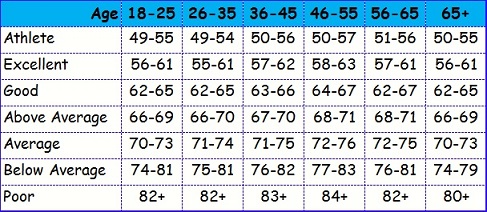The heart is an organ located just behind and slightly to the left of the breastbone, and pumps blood through a network of veins and arteries known as the circulatory system. The right atrium is sent blood from the veins, and delivers it to the right ventricle. It's then pumped into the lungs where it is oxygenated. The left atrium is sent oxygen enriched blood from the lungs and delivers it to the left ventricle, where it's then pumped throughout the body, and the ventricular contractions create blood pressure.
A pulse is the beating of the heart as it's felt through the walls of an artery, such as the radial artery at the wrist. Pulse rates can also be felt and measured at the carotid artery located on the side of the neck, the temporal artery at the temple, or the femoral artery on the anterior side of the hip, and a chart showing normal heart rate can be used to check on your heart rate.
Normal Heart Rate Chart When Resting
A resting heart rate is defined as a pulse that is taken when you are calm, sitting or lying down, and the best time to measure a resting heart rate is in the morning before you leave the bed. Generally speaking, a lower heart rate functions more effectively and efficiently.
How to Take Your Heart Rate

Check your own pulse by placing the tips of your first three fingers lightly on the inside of your wrist below your thumb. You can also check your pulse by placing two fingers on your neck beside the windpipe. You may have to feel around until you feel the pulse beneath your fingers. Once you feel a pulse, use the second hand of a watch or clock to time 10 seconds while simultaneously counting your heart beats. Then multiply the number of heartbeats by 6 to get your heart rate per minute, or number of beats = ______ x 6 = ______beats/min.
Then compare it to the normal heart rate chart below:
|
Age (years) |
Heart Rate (beats/min) |
|
Less than 1 |
100 to 160 |
|
1 to 2 |
90 to 150 |
|
2 to 5 |
80 to 140 |
|
6 to 12 |
70 to 120 |
|
Greater than 12 |
60 to 100 |
|
Well-Trained Athletes |
40 to 60 |
Chart. 1
Chart. 2
Factors That May Affect Your Heart Rate
Normally, your heart rate should have a strong steady rhythm. However, various factors may affect your heart rate and make it different to the ranges in the normal heart rate chart above. You can seek the advice of your health care provider for any health conditions you may have that can affect your pulse. Conditions may include:
Fast Pulse:
- Exercise or activity
- Medication
- Illness or fever
- Anemia
- Heart disease
- Stimulants such as amphetamines, diet pills, caffeine, and tobacco
- Alcohol consumption
- An overactive thyroid
- Stress
Slow Pulse:
- High levels of fitness
- Heart disease and medication for treatment
- Hypothyroidism (underactive thyroid gland)
- Body is at rest
Weak Pulse:
- Peripheral arterial disease (diseases of the blood vessels)
- Chronic heart disease/failure
- Possible blood clot
Normal Heart Rate Chart During Exercise
Your maximum heart rate is the highest heart rate that is achieved during strenuous exercise. One method to calculate your approximate maximum heart rate is the formula: 220 - (your age) = approximate maximum heart rate. For example, a 30 year old's approximate maximum heart rate is 220 - 30 = 190 beats/min.
Target heart rate: You can maximize the benefits and reduce the risks when you are exercising within your target heart rate zone. Your target heart rate when exercising is normally 60 to 80 percent of your maximum heart rate. This may be increased or decreased depending on your health factors, and your health care provider may want you to limit the target heart rate zone to 50 percent. However, it is not recommended to exceed 85 percent of your maximum heart rate. Anything above 85 percent increase risks to the orthopedic and cardiovascular system, with minimal added benefits from the exercise.
Normal Maximum and Target Heart Rate Chart
Besides a normal heart rate chart when resting, there're also normal ranges for heart rate during exercising. The following table shows the approximate target heart rates for various age groups.Find the age group closest to your age and find your target heart rate. The guidelines for moderately intense activities is about 50-69% of your maximum heart rate, and hard physical activity is about 70% to less than 90% of the maximum heart rate.
|
Age |
Maximum Heart Rate (beats/min) |
Target Heart Rate (beats/min) |
|
20 |
200 |
100 to 170 |
|
30 |
190 |
95 to 162 |
|
35 |
185 |
93 to 157 |
|
40 |
180 |
90 to 153 |
|
45 |
175 |
88 to 149 |
|
50 |
170 |
85 to 145 |
How Do You Know If You're in the Normal Zone of Target Heart Rate?
The following guideline will help you measure your heart rate to determine if you are in your target heart rate zone when you exercise.
Stop Momentarily: Measure the number of heartbeats you have for 15 seconds. Then multiply the number of beats by 4 to calculate beats per minute. For example, if you get 40 beats over 15 seconds, take 40 x 4 = 160, and if you are 30 years old, this puts you at the high end of your target heart rate. You can adjust your exercise if you are outside of the high/low target heart rate.

